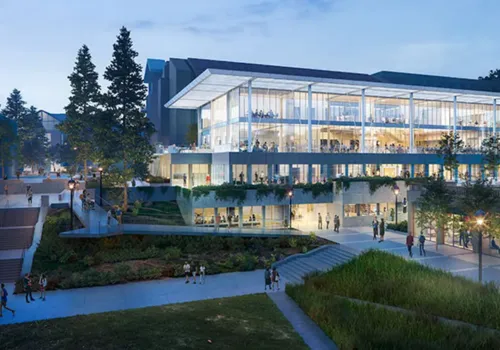
XL Construction completed a remarkable engineering feat in the heart of earthquake-prone Berkeley, California — constructing the $95 million, 35,500-square-foot Grimes Engineering Center atop a 45-year-old library that had shifted 8 inches over time. Located just 1,300 feet from the Hayward Fault, the project required innovation, precision, and an intense focus on seismic resilience.

“This project faced the unique challenge of integrating a 1979 concrete building with a modern addition requiring as much as an 8-inch shift for alignment,” said Erik Russell, Senior Superintendent at XL Construction.
The site’s seismic sensitivity led to the use of shape memory alloy structural cables, a cutting-edge system that allows the building to absorb seismic energy and self-center afterward. “The system allows the structure to absorb energy during earthquakes and self-center afterwards, reducing damage and improving safety,” Russell explained.
The structure was built using a 275-ton crane placed atop the existing library, a logistics challenge in itself. “We essentially built the structure around the crane, adding complexity to material movement,” he said. “Building to precise steel tolerances and a double C-channel design required the engagement of highly skilled welders from across the country.”
The original Kresge Engineering Library remained in use throughout construction, requiring the team to use precision structural shoring to protect the building. “Essentially, we conducted ‘exploratory surgery’ to determine how the new structure could best sit on top of the existing structure while maintaining positive, non-destructive interaction with existing column-reinforcing components,” Russell added.
Technology also played a critical role. “The complex structure required extensive building information modeling coordination,” he said. XL used re-scanning and 2D overlays to align misaligned grid lines and correct deviations from old blueprints. “BIM coordination was successful in preserving the integrity of architectural features, allowing them to remain exactly where the design indicated despite the structural and systems complexity.”
The Grimes Engineering Center, designed by Skidmore, Owings & Merrill, is a symbol of how new construction can respect and integrate historic structures while preparing for future seismic events. The use of shape memory alloys (SMAs) — tested at UC Berkeley’s own Davis Hall — marked a first in U.S. structural installations, emphasizing the project’s innovative engineering.
Located in a tight, urban space within UC Berkeley’s active campus, the project required precise coordination with university officials, student schedules, and safety protocols. Despite spatial constraints and seismic risks, the project achieved architectural and structural continuity, showcasing the future of adaptive reuse and earthquake-ready building in higher education.
With its fusion of historic preservation, forward-thinking design, and seismic resilience, the Grimes Engineering Center sets a precedent for complex urban infill construction in seismic zones.
Originally reported by Joe Bousquin in Construction Dive.